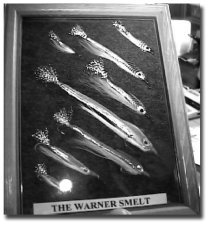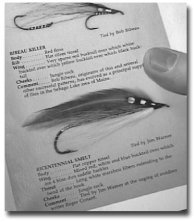|
[?]Subscribe To This Site
|
Trolling For Fish
|
| Month | Salmon | Lakers | Rainbows | Bass |
| May | Top to 5-10' | Top to 5-10' | Top to 5-10' | 0-5' |
| June | Top to 5-20' | 10-25' | Top to 5-20' | 0-10' |
| July | 5-30' | 20-50' | 5-20' | 15-25' |
| August | 10-35' | 20-50' | 10-35' | 15-25' 0-10' night |
| September | 10-20' | 20-50' | 10-20' | 15-25' 0-10' night |
| October | Closed | Closed | Closed | 5-10' 0-5' night |
| Ice Fishing | Closed | Depth varies | Depth varies | Bottom |
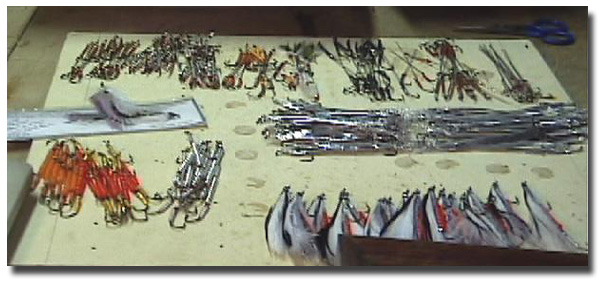
Comments on lures in general:
- For spring trolling for cold water species (trout and salmon): Use streamer flies. Lures such as Mooselooks, Chev Chase, spinners with bait such as a worm or minnow, live smelt on single small hook, Rapala type lures, pimple lures, etc (just about anything on the market which imitates a swimming bait fish.) I even created a fly to imitate the old popular balsa wood Flat Fish lure.
- Summer fishing might include all the above but only trolling for fish at different depths.
- Though fall fishing can be "iffy", use the same flies and lures when trolling for fish.
- Different tactics for the warm water species such as bass and perch.
Some of these lures mentioned above are OK, such as the Rapala type lure, but live bait is usually more effective for daytime fishing.
One of the favorites for bass is the hellgrammite, the larval stage of the Dobsonfly. Bass go crazy for helgies if fished properly. Some helgies can be found along the shore of Lake Winni, but crawfish are the natural food for bass, as they can be found most anywhere on the bottom of the Lake. (Although not the norm, I have found crawfish in the innards of salmon.).
Minnows are also a good part of the bass diet and many kinds of shiners or minnows can be found along the Lake's shoreline. Where minnows can be fished at all depths, helgys and craws are usually fished on the bottom.
Night crawlers are sold in great quantities around the Lake and they have resulted in the catching of many good bass by young and old.
Bass fishing on top water in late spring, daytime into the evening hours is fantastic! Top water gurgling, bubbling noisy plugs are my favorite. Casting into shore is best, but trolling for fish is also good, but, at night, one is not sure of navigation around boats and various buoys.
• Ice Fishing in New Hampshire:
Bait for ice fishing is 90% the live type. Live smelt, if they can be found, are the best. Jigging with pieces of smelt can provide the angler with some nice perch or a laker or cusk. Live swimming smelt on the tip up can be deadly for all species.
There are some very deep holes, which some fishermen covet over the years to bob out jack smelt. When the bait smelt are not available, then there is the emerald shiner that was introduced into Lake Winni in the 1950's. They are far more hardy and live longer than the fragile smelt.
The red fin shiner, a native of Lake Winni, is nearly extinct. However, these are used for tip ups too. There are other types of shiners imported from New Hampshire waters and sold for bait around the Lake.
As far as ice-fishing lures go, the pimple type is used most of the time. Ice flies have been tried as well, but not often.
• My largest fish taken on Lake Winni:
Landlocked Salmon:
May 1957, 7 pound 2 oz. On a small Marabou fly. Off the dock at Wolfeboro in 15 feet of water
Lake Trout:
Many, but none enormous enough to list
Rainbow Trout:
September 1958, 6 pounds, 5 oz "Wolfeboro Bay Special Fly", off Clark Point out side of Wolfeboro Bay in 5-10 feet of water.
Smallmouth Bass:
July 1966, 6 pounds, on a Crazy Crawler at 7 PM Behind Melody Island in Alton on the surface.
Yellow Perch:
1949 2+ pounds through the ice off Rattle Snake Island on cut bait
Cusk:
1970 or 1971, 11 pounds, in Winter Harbor on small yellow perch
Pickerel:
Almost 5 pounds, off my dock in Winter Harbor on a daredevil in shallow water
I share below two stories about the above and one on the "The one that got away."
A true salmon fishing story:
Years ago, in the late 1950s into the early 1960s, the dockside or the Smith River, as it enters Lake Winni at Wolfeboro Bay, was a Mecca of fishermen with bait or flies.
The better fishing would depend upon the amount of water being released out of Crescent Lake upstream. To swim into the river mouth, salmon needed a current.
As owner and proprietor of the Sportsman Center, I ran an "off the dock" fishing contest in May of 1957. There were many entries of salmon to 4 pounds or better. On any given day, I would take my lunch break and take a turn with my fly rod at the salmon in the river.
There was one particular salmon that had caught every angler's eye, and it moved back and forth in the clear current, refusing all morsels that came its way. Darned if I didn't hook and land that fish! He weighed in at 7 pounds 2 ounces, and a picture of him is here in these pages.
There was a bit of hard feeling amongst the fishermen that day, but they all calmed down when I "disqualified" myself and went back to work. Just one week later a fisherman from Milton Mills landed a salmon of 8 pounds 14 ounces, which clinched the prize.
Smallmouth Bass angling in Lake Winni has always been fantastic. When running a store, fishing time is limited to early mornings or late evenings.
A friend and I used to leave my dock at 8 in the evening with a canoe strapped on and down the lake we would go to the Whorttleberry Island area, where there were lots of rocky shoals and spots where the bass would come into the shallows to feed late in the evening. This was a great area.
Another excellent area for bass was a pothole behind Melody Island, where bass would come in from the deeper waters to feed. (I guess I am old enough to be willing to violate Hal's statement that we Master Anglers will not share our secret spots!)
I was trolling for fish there with a buddy and we were catching a few smaller 2-3 pounders. It was getting really dark and I said that I would make just one more last cast. An explosion engulfed my black Crazy Crawler plug and I was fast to a real monster!
Two guys in a canoe is bad enough, but this fish decided to go under the canoe and with it my spinning rod bent in an almost complete circle under the boat. Then the monster jumped.
What a magnificent fish! But its next jump was over the front of the canoe that wrapped the line twice around the canoe! How we ever landed that fish had to be a miracle, but was very well hooked!
The next morning it was on display at my store on ice in downtown Wolfeboro, New Hampshire...which caused quite a stir among the local anglers. How I wish I had that adventure on video!
"The fish that got away…" did so with fly and leader. It was a magnificent salmon -- perhaps 8-9 pounds.
I was trolling for fish between Ship Island and Black Point in the "triangle," an area known for good deep lake trolling. I had a full 200 yards of copper wire line out with a yellow marabou fly attached to my long leader.
I was trolling for fish using the "8's" and circles as Glen Morrill had taught me, when a fish hit hard. Before I could reel in the slack, I saw the fish break water and leap clear into the air. He came down on my light leader and it broke!
I just kept reeling in the slack…but I had the sight and the memory of a truly beautiful fish -- the biggest I have ever hooked.
• Passing on my skills:
This is a sticky question for me. In one sense, I must answer with a qualified "no," except through these pages.
But in my career running a successful fishing store, I believe that I had a unique opportunity to share and pass on much of my experience, not only to my customers and friends, but also to the younger generation of anglers.
I tried to freely pass on all I had learned. The field I am most noted for in the Lakes Region is that of tying streamer flies.
After almost 53 years of tying and creating new patterns, I have also taught fly tying to young people in many of the boy's camps, high schools, and other places.
I believe that I am the original creator of many well known Lake Winni flies including the "Lake Winni Smelt." Perhaps this is how I will be remembered more than I will as a "Master Angler."
One of my proudest achievements was teaching a young man in 1995 to tie flies under the auspices of the New Hampshire Council of the Arts. Yes, fly tying is a creative art.
• My top 5 tips for each fish:
Salmon:
- Adjust your trolling speed to the action of the lure trolled.
- Try to increase and decrease your speed to put different action on the fly or lure.
- While trolling for fish do not troll in a straight line.
- Fish early or late in the day, and fish the shoreline where the water is roughest from the wind, as baitfish tend to congregate in these spots.
- Dark flies such as "9-3", the "Magog Smelt" or the Bicentennial Smelt are best in the early morning hours as well as evening.
Lake Trout:
- Trolling for fish using live bait is the best for lakers.
- A slower speed is necessary for lakers to get the trolled lure or bait below or under the other salmonoid species that are above the lakers.
- An important rule for lakers, or any big fish, is to use a large net and when landing one, always lead the fish to the net headfirst.
- Big lakers and salmon can sometimes be found "on top" at first light in the morning. Cast a light line and lure beyond their swirls and sometimes they will strike on instinct.
- When trolling for fish deep in the summer months, try to bring in your fish as slowly as possible, if it is your intention to release it. Coming up from the deep-water causes a case of the bends for the fish, and it is mostly impossible to revive and save them.
Rainbow Trout:I never went out trolling for fish just for rainbows. They were introduced into Lake Winni only in later years. On one occasion in 1958, before they were stocked, I caught one off Clark Point. This species was not a native of Lake Winni.
I can only think that this one I caught was "there" because of a stocking mistake, or this might have been one of the "Bows" that got away when the Melanesian Pond dam broke years before in Wolfeboro.
But any tips I might list for rainbows might follow those I have listed for salmon as they are quite similar in habitat and feeding, except that the rainbows consume more terrestrials (insects) than salmon and they often come nearer to the surface.
• Catch & Release:
Black Bass:
- Bass are easiest to catch when on their spawning beds in the shallows in the spring. This is also the time to catch and release!
- The best time for bass in the summer is after dark. This is when most boating ceases and you are virtually alone to fish. Bass come into the shallows looking for a late dinner and are easily fooled by noisy top-water plugs.
- When trolling for fish using live crawfish or hellgrammites, use a fairly large egg sinker so that when the bass picks up the bait and runs with it, there should be little or no resistance on the line. The bass might feel it and spit out the bait.
- After a bass has run out a measure of line, then stops running, then takes off again, it is then on the second run that you should set the hook. He has usually swallowed the bait by then and he is yours…if you play him carefully and do not let him break the line. If you keep him for eating it is fine, but if you want to release a gut caught fish, you must clip the line inside his mouth. The hook will later rust out of his gut.
- Some of the best bass fishing on the Lake can be found in October. Try casting toward the shore where the bass have moved back to cooler water.
Ice Fishing:
- Stay off the ice until it is safe! I can remember a scary time out on Wolfeboro Bay, New Hampshire with the cracking and sinking just under my weight. Of course, I HAD to be there because I had a smelt house there for my store…and was carrying a pail of fresh-netted smelt back to shore.
- When tip-up fishing on very cold and windy days, scuff some snow into the hole. This will insulate the opening and it will be easy to clean out to check the lines.
- Never use an ice chisel without a line tied to it.
- Tie your bob house down with sticks in the frozen ice, or the next warm windy day you might find your house (and you in it!) sailing down the lake.
- Put big skis on your bob house as runners, so that it can be moved to shore after the heavy March snowstorms.
At this time of my life I do mostly catch & release. To clarify, there comes a time in your life when you just feel sorry for the other being, whether it be animal, fish or fowl.
I shot my last deer 10 years ago. I remember feeling so sorry about it, that I gave up deer hunting that day. After I put my last hunting dog down, I gave up bird hunting. Unless a fish obviously will not live after catching it, I throw it back.
This has not always been the case. In younger days, I felt it necessary to feed the family. We enjoyed lots of salmon filets, fried brook trout, deer steaks, duck stew, cusk chowder, etc.
Now, I jokingly state that my wife refuses to clean the fish, so I throw them back. But catch & release has always been a good part of my fishing life, too. We never kept everything.
I can remember fishing the Winnipesaukee River in 1950 and rarely keeping a nice fly rod caught salmon. There were many fish caught in Lake Winni in my trolling days that were released. I love to fish! Having one to eat was OK too, but not necessary.
Over the years I have fished in many countries, mostly, though, in North and Central America. Except for "camp food" fish were rarely kept. So practice catch & release? Yes!
• What happened to the Lake Winni Yellow Perch?
Well, I have a theory. It is my opinion that they have fallen prey to the thousands of Mergansers that flock to Lake Winni in the fall, on their migration south. In the fall of the year, I used to see large schools of newly hatched perch from my dock in Winter Harbor. It was not uncommon to also see schools of red fin shiners, horned pout, and lots of bass fry from my dock.
But in the 1980's through the 1990's, every late fall before ice forms, hundreds of these ducks would land in the Harbor and spread out, moving along the shore, diving and feeding for hundreds of yards. This had to contribute to the decline of forage fish like the yellow perch. Smelt, on the other hand, are found in deeper water where the ducks cannot get at them.
• What about the Whitefish or "Shad?"
A year or so ago, I asked Pete Lyon, an ex-game warden and fishing friend, about the shad. He said that Lake Winni's shad population was never that good, although early last century the shad were a wonderful fish to catch and eat. But they were never that abundant.
He felt that Lake Winni is on the southern most fringe of the shad habitat. In lakes such as Squam and Sebago, White fish or shad can be found in more abundance.
Years ago I asked a New Hampshire Fish & Game biologist this same question. His theory was that shad spawn in the late fall or early winter and under the ice. If the Lake has not frozen when this spawning occurs, then the eggs are washed to shore. I tend to agree with Pete's theory…but who knows for sure?
A salmon sniffing dog:
By the way, Pete Lyon is the famous game warden who trained a black lab to seek illegal salmon that poaching ice fishermen had hidden in the snow. He trained his dog, "Poacher" to ignore trout, perch, and all fish except salmon.The story is told that on one occasion he stopped in at a bob house on Lake Winni where three men were keeping warm while jigging.
Pete asked, "How you doing, boys?" "It is slow," one replied. While talking with them, one of the men looked out the window and said, "Your dog is going wild out there digging in the snow banks!" Pete replied, "Yes, he likes to dig in the snow." A minute later the dog was scratching at the door and Pete let him in carrying a nice frozen salmon in his mouth which he dropped at Pete's feet. One of the anglers stammered, "Where did he find that salmon!" Pete let him out again and he repeated this strange act …5 more times! Finally, realizing that the jig was up, one of the men, said, "That's the most amazing thing I have ever seen! We surrender! Whatever we owe in fines, it is has been worth it just watching your amazing dog!"
• Would I stock Lake Winni with other species?
NO Way! There can be no good reason to bring a new species to Lake Winni to compete with an already scarce food supply. If more species were introduced, they would have to find forage fish.
Can you imagine what coho salmon might do to the smelt population? And brown trout rarely are caught until after dark, and it is unlawful to fish after the sun goes down for the salmonoid species in Lake Winni.
• One more fish story:
The one true happening, which comes to my memory, occurred on a hot day. It was a traditional family gathering at a camp on the Lake in the late 1950s.
It was a hot 4th of July. The beer was plentiful and the spirits were high. My brother-in-law suggested that we go trolling for fish. Well, I'm never without some sort of fishing tackle.
This day, I had a heavy 9-foot trolling rod, loaded with 10-pound test wire trolling line and a tackle box full of lures. Out we went onto the smooth, windless lake. I had few thoughts about catching anything, but we were trolling for fish for an hour with fishless conversation.
Finally, I suggested that we troll along the shore back to camp. I mentioned to Leo that I would put on a large Rebel Minnow and let out most of my line. And I said, "When I hit bottom and lose the lure, we'll go back to camp."
It didn't hit bottom, though it could not have been deeper than 15 feet. Suddenly I had a fish on…and it was a monster! After a brief throbbing struggle, I was able to bring it along side the boat. It was the biggest laker we had ever seen! And it was thoroughly hooked on the rear hook of the Rebel. It kept swimming around the boat with me just holding on…and Leo grabbing the only net - a small 12-inch diameter one.
We should have never tried to net it but rather just go to shore and beach it. But we tried…and it just rolled off, with the hook suddenly pulling out. Both of us just watched open jawed, as it swam slowly away.
Later that week I asked a fish biologist how much it must have weighed, telling him the dimensions, as its back was fully 8 inches across and he told me that this was probably one of those 20+ pounders. What a day! What a memory of my biggest "… fish that got away!"
• My Favorite recipes:
Well, we have cooked and eaten about every game species in Lake Winni. And the tiny smelt is, in my opinion, the most delicious. There have been many good "messes" of fried smelt, with heads intact and without, at our table over the years.
- The best way to prepare smelt is to pop them into a hot, greased frying pan, and when golden brown, enjoy!
- Yellow perch, although larger, I cook and fry the same way.
- Cusk is best for a chowder, but cusk filets are also truly delicious!
- Pickerel are very bony, but also make a great chowder.
- Hornpout, once skinned, are a very tasty fried fish.
- I prefer Lake Trout to be baked in milk.
- Salmon, I filet and grill over an outdoor fire with lemon and butter.
- Bass, according to size, can be baked or filets can be grilled or fried.
• What about the Mercury warnings and scares?
Though I do not know much about this, I am sure that it has been a problem for a very long time…we just did not monitor it or know about it.

To order the complete award-winning book, Angling in the Smile of the Great Spirit, or its accompanying DVDs featuring live interviews with the Master Anglers of Lake Winni, please go to: www.deepwaterspress.com





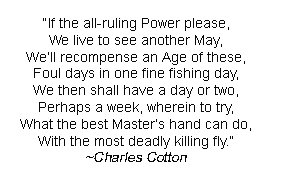

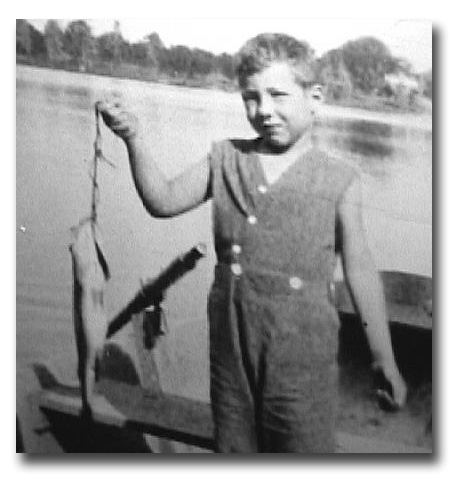
 “My dear wife would probably say, ’You can’t write a short anything.’ She has always been right (she says). My fishing experience on Lake Winnipesaukee first started in 1949, when I married a Laconia gal.
“My dear wife would probably say, ’You can’t write a short anything.’ She has always been right (she says). My fishing experience on Lake Winnipesaukee first started in 1949, when I married a Laconia gal. 
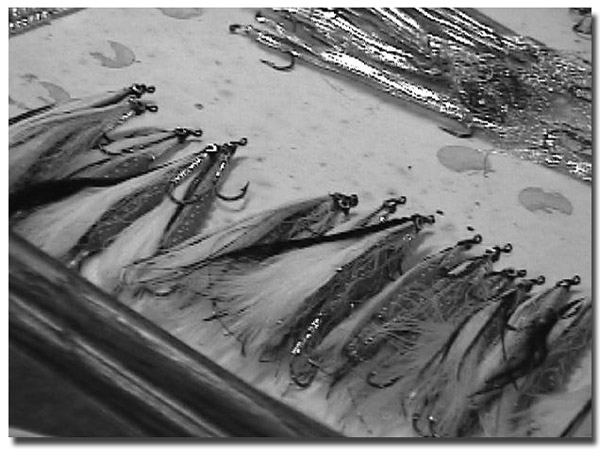
 “My fly-tying has been listed in several books: Dick Stewart’s Trolling Flies for Trout & Salmon; Dick Surette’s Trout and Salmon Fly Index; Don Wilson’s Smelt Fly Dressings; Mike Martinek’s Streamer Fly Patterns for Trolling & Casting 1 & 2; many periodicals such as On The Water, UFT, etc; and many newspaper articles…. too many to describe.
“My fly-tying has been listed in several books: Dick Stewart’s Trolling Flies for Trout & Salmon; Dick Surette’s Trout and Salmon Fly Index; Don Wilson’s Smelt Fly Dressings; Mike Martinek’s Streamer Fly Patterns for Trolling & Casting 1 & 2; many periodicals such as On The Water, UFT, etc; and many newspaper articles…. too many to describe. 